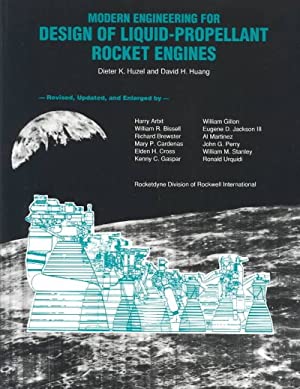Modern Engineering for Design of Liquid Propellant Rocket Engines by Dieter K. Huzel, ISBN-13: 978-1563470134
[PDF eBook eTextbook]
- Publisher: AIAA (American Institute of Aeronautics & Astronautics); Revised, Subsequent edition (January 1, 1992)
- Language: English
- 431 pages
- ISBN-10: 1563470136
- ISBN-13: 978-1563470134
From the component design, to the subsystem design, to the engine systems design, engine development and flight-vehicle application, this how-to text bridges the gap between basic physical and design principles and actual rocket-engine design as it’s done in industry.
Over the quarter-century since publication of the original text of this book, astronauts have landed on the Moon and deep-space probes have visited all of the planets of our solar system. All of these undertakings depended entirely on rocket power. So will future space projects of many kinds, such as the Space Station Freedom, communications and exploration satellites, space ferries and shuttles, space probes, and, in the more distant future, Moon settlements.
Throughout the decades since Robert Goddard made his first l p-rocket launching in 1926, these thrust-producing devices, both turbopump-fed and pressure-fed, have assumed various shapes, sizes, configurations, and “cycles,” depending on application, chosen thrust level, propellant type, and several other, often special, factors. One aspect has not changed: the basic physical and design principles.
In the context of practical design experience, this book introduces the reader to these basic principles; but more to the purpose, it supplies the bridge for the student and the young engineer from rocket propulsion fundamentals (otherwise well covered in the literature) to actual rocket-engine design and development work as done in industry (very little, if at all, covered in the literature). The book emphasizes realistic application of rocket propulsion theories, and this should help avoid, or at least reduce, time- and money-consuming errors and disappointments. In so doing, it consolidates numerous closely related subjects, hitherto often treated separately, bringing them up to date at the same time.
This book was written “on the job” for use by advanced students and engineers active in all phases of engine systems design, development, and application, in industry and government agencies. It presents sufficient detail to familiarize and educate those responsible for various aspects of liquid-propellant rocketry, including engine systems design, engine development, and flight-vehicle application. It should enable the rocket engineer independently to make preliminary detail designs for complete or partial engine systems and to understand and judge the problems, limitations, and “facts of life” of the various subsystems making up a complete engine system. It also aims to educate those ultimately interested in specialized subsystems and component design (thrust chamber, turbopump, control valves, etc.) about their own as well as neighboring subsystems and about the complete engine system. This should enable the beginner to prepare realistic analytical calculations and design layouts with a long head-start toward the final specialized design for subsystem production release.
This book addresses the young in a special way. Many of us who contributed to past projects are now retired or are about to retire. Some experienced hands have passed away. It is immensely important that the skills, experience, and know-how of this earlier generation be preserved and passed on to a younger generation–clearly, completely, and effectively. Losses would be costly. There must not be a gap. The managers of the many companies that form the rocket-engine industry and the pertinent government agencies are quite aware of this danger, and are employing various “in-house” programs to meet it.
This book makes a valuable contribution to that goal. The original authors stood among the forefront of design and development teams of larger propulsion systems, and Dieter Huzel spent several years in “long-life technology” work. David Huang for many years directed advanced rocket-engine design and development.
What makes us different?
• Instant Download
• Always Competitive Pricing
• 100% Privacy
• FREE Sample Available
• 24-7 LIVE Customer Support





